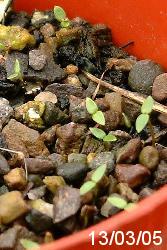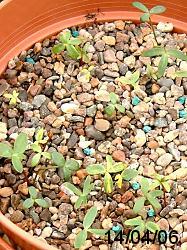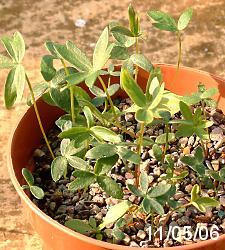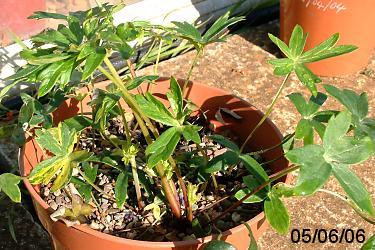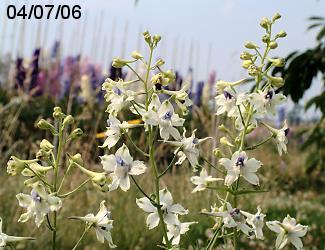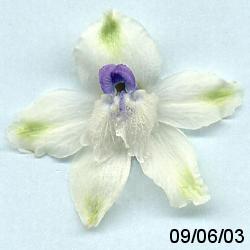| North
American Delphinium Species |
A guide to stages in seedling development
D. leucophaeum is listed in the Flora of North
America as a sub-species, 'ochroleucum', of D.
nuttallii that it closely resembles except in the colour of
the flower, which is pure white apart from blue tips of the upper
petals. This delphinium is found locally on rocky outcrops and
rocky meadows in northern Oregon close to the Willamette and
Columbia rivers.
Seeds were sown in mid-January 2004 on the
surface of peat-based multi-purpose compost and lightly covered
with compost and a thin layer of grit. The pot was left outdoors
exposed to the weather, which included periods of rain and some
overnight frost. A few seeds germinated by the end of May but
there was no significant germination until after a second winter,
when many seedlings appeared in May 2005. These did not appear to
develop further before disappearing and remained in the pot until
spring 2006, when the first true leaves began to emerge through
the moss covering the surface in late March. It seemed desirable
to 'rescue' the delphiniums before root entanglement resulted in
too much damage. This was very difficult and it was necessary to
wash out all the compost. The delphinium seedlings were found to
have tiny round tubers about 2mm in diameter with little root.
Their chances of survival seemed small, so groups of ten or more
seedlings were replanted together in large pots of compost.
To our surprise, these seedlings recovered well
and grew steadily larger. Flower stems began developing in early
June, as seen in the picture below.
Rapid growth continued during the extremely hot
weather in June with many stems having flowers opening at the
start of July, as seen in the picture below. The flowers set seed
but the plants were growing close to plants of D. nuttallii
with open flowers so it will be interesting to determine if the
seeds from D. leucophaeum yield plants with blue flowers
as a result of hybridisation.
For several years, Shirley has grown D.
leucophaeum successfully under glass. The picture of a
single flower above was taken by pushing the flower stem through
a slot cut in a sheet of blue paper, placing this 'flower-page'
on a document scanner and then scanning the image into the
computer.
The most fascinating feature of this species is
the presence of blue petals in the eye of a white flower. This
does not normally occur in garden hybrid delphiniums with white
flowers, even if these have blue-flowered cultivars in their
parentage. We are uncertain if there are other species in which
this 'inversion' of the sepal and eye colour occurs but the
description of D.albiflorum, a species from northern
Greece and Bulgaria, suggests that it is possibly another example.
